 W
WAn Impound race is a race where the crew members are not allowed to make any adjustments to the car after qualifying and before the race.
 W
WBargeboards are pieces of bodywork on open-wheel racing cars, serving a purely aerodynamic function. They are curved vertical planes situated longitudinally, between the front wheels and the sidepods, held away from the chassis at the front on struts or other connectors, and connecting to the sidepods or extensions of the floor at the rear. In general, they are significantly taller at the front than at the rear making them trapezoidal in profile, and they curve outward in plan view, being closer to the centerline of the car at the front, and curving out towards the rear. Bargeboards were introduced by McLaren at the 1993 South African Grand Prix, before being adopted by Benetton and other teams.
 W
WBroadsiding is the method used in motorcycle speedway for travelling round the bends on the speedway track. The rider skids his rear wheel by spinning it at such a speed that it sets up a gyroscopic action and this opposes the natural tendencies of centrifugal force. Then he controls the slide by throttle control to maintain, increase or decrease the rate of which the rear wheel spins. Motorcycle speedway bikes have no brakes or suspension. The rider can scrub-off speed while still providing the drive to power the bike forward and around the bend.
 W
WA Burt strut, also known as a timing strut or beam splitter, is a black, rectangular plate attached to the front of a competition vehicle, usually a racing car, to provide a standardised, repeatable method by which to break a timing light beam at the start and finish of events timed to high-degrees of accuracy. These events are commonly those in which competitors race against the clock, rather than physically against another vehicle, such as sprint or hillclimb races. The strut was invented in 1967 by Ron Smith; manager, chief mechanic and future husband to 1970 British sprint champion Patsy Burt. As the strut made its first appearance on the front of Burt's McLaren-Oldsmobile her name was used as its official title. In recent years the generic term timing strut has also become common.
 W
WA co-driver is the navigator of a rally car in the sport of rallying, who sits in the front passenger seat. The co-driver's job is to navigate, commonly by reading off a set of pacenotes to the driver. Some competitions require map interpretation. In stage rallying communication is often over a radio headset, due to the high level of noise in the car. The co-driver also tells the driver about any incidents or accidents that may have occurred further ahead in the stage. This role is particularly critical in high-end rally competitions such as WRC. Co-drivers are also often called on to perform maintenance on the car during road sections and special stages, such as changing a wheel.
 W
WCommon in auto racing, contingency sponsorship is a form of sponsorship whereby race teams place company decals on their vehicles in exchange for awards for winning or meeting certain performance goals. These awards can be monetary or can include credits for free or discounted equipment.
 W
WA diffuser, in an automotive context, is a shaped section of the car rear which improves the car's aerodynamic properties by enhancing the transition between the high-velocity airflow underneath the car and the much slower freestream airflow of the ambient atmosphere. It works by providing a space for the underbody airflow to decelerate and expand so that it does not cause excessive flow separation and drag, by providing a degree of "wake infill" or more accurately, pressure recovery. The diffuser itself accelerates the flow in front of it, which helps generate downforce. This is achieved by creating a change in velocity of the air flowing under the diffuser by giving it a rake angle which in turn generates a change in pressure and hence increases downforce.
 W
WDouble Duty also referred to as the Indy-Charlotte Double or Memorial Day Double, is an auto racing term centered around two events held on Memorial Day weekend in most years. The two events are the annual Indianapolis 500, which is the most important Indycar Series race held at the Indianapolis Motor Speedway in Indiana, and the annual Coca-Cola 600, which is a NASCAR Cup Series race held at the Charlotte Motor Speedway in North Carolina. These two events are regarded as significant events for their respective series, as the Indianapolis 500 is the most prestigious race for Indycar while the Coca-Cola 600 has for years been considered one of NASCAR's most important races.
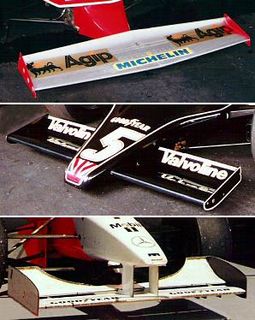 W
WDownforce is a downwards lift force created by the aerodynamic characteristics of a vehicle. If the vehicle is a car, the purpose of downforce is to allow the car to travel faster by increasing the vertical force on the tires, thus creating more grip. If the vehicle is a fixed-wing aircraft, the purpose of the downforce on the horizontal stabilizer is to maintain longitudinal stability and allow the pilot to control the aircraft in pitch.
 W
WDrafting or slipstreaming is an aerodynamic technique where two vehicles or other moving objects are caused to align in a close group, reducing the overall effect of drag due to exploiting the lead object's slipstream. Especially when high speeds are involved, as in motor racing and cycling, drafting can significantly reduce the paceline's average energy expenditure required to maintain a certain speed and can also slightly reduce the energy expenditure of the lead vehicle or object.
 W
WIn motor racing, the drag reduction system (DRS) is a form of driver-adjustable bodywork aimed at reducing aerodynamic drag in order to increase top speed and promote overtaking. It is an adjustable rear wing of the car, which moves in response to driver commands. DRS often comes with conditions, such as the pursuing car must be within a second for DRS to be activated.
 W
WDrifting is a driving technique where the driver intentionally oversteers, with loss of traction, while maintaining control and driving the car through the entirety of a corner. The technique causes the rear slip angle to exceed the front slip angle to such an extent that often the front wheels are pointing in the opposite direction to the turn. The sport of drifting is not to be confused with the four wheel drift, a classic cornering technique established in Grand Prix and sports car racing. Drifting is traditionally done by clutch kicking, then intentionally oversteering and countersteering.
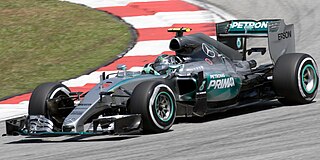 W
WIn motorsports, a factory-backed racing team or driver is one sponsored by a vehicle manufacturer in official competitions. As motorsport competition is an expensive endeavor, some degree of factory support is desired and often necessary for success. The lowest form of factory backing comes in the form of contingency awards, based upon performance, which help to defray the cost of competing. Full factory backing can be often seen in the highest forms of international competition, with major motorsport operations often receiving hundreds of millions of euros to represent a particular manufacturer.
 W
WA five-point harness is a form of seat belt that contains five straps that are mounted to the car frame. It has been engineered for an increase of safety in the occurrence of an automobile accident. As a result, this form of seat belt has been mandated in the race car competition of NASCAR. This was an invention made mandatory to have due to the high velocities involved in the sport. Along with the design of the seat belt, helmet straps have been designed to increase the safety of the driver. This invention has also been used to secure infants and young children in child safety seats.
 W
WA formation finish in a motor race is when multiple vehicles of the same team cross the finish line in formation, usually side-by-side. Typically it happens when a team's car are running in the top positions at the end of the race with a clear advantage over their competitors. Team directors often orchestrate formation finishes to demonstrate their superiority. A formation finish should not be confused with a "1–2 finish"; not all formation finishes occur as a result of a team's cars finishing first and second in a race, and not all 1–2 finishes are completed in formation.
 W
WA hairpin turn is a bend in a road with a very acute inner angle, making it necessary for an oncoming vehicle to turn about 180° to continue on the road. It is named for its resemblance to a bent metal hairpin. Such turns in ramps and trails may be called switchbacks in American English, by analogy with switchback railways. In British English "switchback" is more likely to refer to a heavily undulating road—a use extended from the rollercoaster and the other type of switchback railway.
 W
WThe holeshot is a motorsport terminology to describe a rider who has the strongest start to get up to racing speed. It is usually the driver who leaves a starting area first from a standing start.
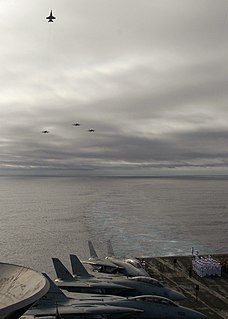 W
WThe missing man formation is an aerial salute performed as part of a flypast of aircraft at a funeral or memorial event, typically in memory of a fallen pilot, a well-known military service member or veteran, or a well-known political figure.
 W
WMonkey seat is a term used in Formula One to describe a small wing underneath the main rear wing of the car that uses a loophole in the bodywork regulations to generate a small amount of additional downforce.
 W
WA parade lap, also known as a pace lap, formation lap or warm-up lap, is a lap before a motorsport race begins, in which the drivers go around the track at a slow speed, and, in some cases, behind the safety car. The lap is to ensure that track conditions are safe, and that there are no dangerous problems with the cars or the circuit. The parade lap either leads to a rolling start, standing start, or back to the grid. Short circuits often have two of these laps. Overtaking is usually permitted on these laps in motorcycle racing, but not in car racing.
 W
WParc fermé, literally meaning "closed park" in French, is a secure area at a motor racing circuit wherein the cars are driven back to the pits post- and sometimes pre-race. For example, according to the FIA Formula One regulations, the area must be sufficiently large and secure so as to prevent unauthorised access to the cars, while allowing technical checks to take place. Cars must be placed in parc fermé within three and a half hours from the end of qualifying until five hours before the start of the race formation lap. Essentially, cars in this area must not be touched by anyone without express permission of the FIA stewards.
 W
WIn motorsports, a pit stop is a pause for refuelling, new tyres, repairs, mechanical adjustments, a driver change, as a penalty, or any combination of the above. These stops occur in an area called "the pits", most commonly accessed via a pit lane which runs parallel to the start/finish straightaway of the track and is connected to it at each end. Along this lane is a row of garages outside which the work is done. Pit stop work is carried out by anywhere from two to twenty mechanics, depending on the series regulations, while the driver often waits in the vehicle.
 W
WIn motorsports, the pole position is the position at the inside of the front row at the start of a racing event. This position is typically given to the vehicle and driver with the best qualifying time in the trials before the race. This number-one qualifying driver is referred to as the pole-sitter.
 W
WA promotional model is a model hired to drive consumer demand for a product, service, brand, or concept by directly interacting with potential customers. Most promotional models are conventionally attractive in physical appearance. They serve to make a product or service more appealing and can provide information to journalists and consumers at trade show and convention events. Promotional models are used in motorsports, other sports or at trade shows, or they can act as "spokesmodels" to promote a specific brand or product in advertisements.
 W
WRacing flags are traditionally used in auto racing and similar motorsports to indicate track condition and to communicate important messages to drivers. Typically, the starter, sometimes the grand marshal of a race, waves the flags atop a flag stand near the start/finish line. Track marshals are also stationed at observation posts along the race track in order to communicate both local and course-wide conditions to drivers. Alternatively, some race tracks employ lights to supplement the primary flag at the start/finish line.
 W
WA riding mechanic was a mechanic that rode along with a race car during races, and who was tasked with maintaining, monitoring, and repairing the car during the race. The various duties included manually pumping oil and fuel, checking tire wear, observing gauges, and even massaging the driver's hands. They also communicated with the pits and spotted from inside the car. If the car ran out of fuel, or otherwise broke down, the riding mechanic was usually responsible for running back to the pits to fetch fuel or the necessary spare parts.
 W
WA rolling start is one of two modes of initiating or restarting an auto race; the other mode is the standing start. In a rolling start, the cars are ordered on the track and are led on a certain number of laps at a pre-determined safe speed by the safety car.
 W
WA roof flap is an aerodynamic feature on race cars, mainly stock cars, which functions as an emergency spoiler to prevent the vehicle from lifting off the ground. The flaps are stowed during normal vehicle operation; however, in certain situations, e.g., if the vehicle goes into a spin, particularly if it is facing backwards, the flaps deploy to disrupt the air flow over the roof and reduce the lift force on the vehicle.
 W
WA run-off area is an area on a motorsport race track for racer safety. Run-off areas are usually located along a road racing circuit where racers are most likely to unintentionally depart from the prescribed course. There are different types of run off areas like gravel trap, AstroTurf and tarmac. Run-off areas are an alternative to catch fences.
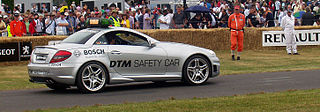 W
WIn motorsport, a safety car or pace car is a car which limits the speed of competing cars on a racetrack in the case of a caution period such as an obstruction on the track or bad weather. The aim of the safety car is to enable the clearance of any obstruction under safer conditions, especially for marshals and/or await more favourable track conditions weather-wise.
 W
WA shift light is a warning lamp fitted to vehicles in order to indicate to the driver that maximum revolutions per minute (r/min) has almost been reached. Ideally a shift lamp will illuminate at the engine speed beyond that which delivers the maximum power, measured in for example kilowatt (kW) or brake horsepower (BHP), such that the power before and after shifting is the same. Accelerating the engine beyond this point is not conducive to rapid acceleration. In use a shift light allows the driver to judge the exact point that a gear change should be carried out without having to glance down at the tachometer. This also increases safety for the driver by keeping his focus on the track at all times.
 W
WA silhouette racing car is a race car which, although bearing a superficial resemblance to a production model, differs mechanically in fundamental ways. The purpose of silhouette cars is to provide a manufacturer with a tangible link to their consumer product offering so as to derive maximum marketing benefit from their investment in the sport. They also provide spectators with familiar car models with which they can identify.
 W
WSpinning is a South African motorsport that involves driving cars at speed in circles and performing stunts in and out of the car. It originated in Soweto in the late 1980s, and was performed as a funeral ritual in which a stolen car was spun around to honor the deceased. It is now a recognized motorsport.
 W
WA spoiler is an automotive aerodynamic device whose intended design function is to 'spoil' unfavorable air movement across a body of a vehicle in motion, usually described as turbulence or drag. Spoilers on the front of a vehicle are often called air dams. Spoilers are often fitted to race and high-performance sports cars, although they have become common on passenger vehicles as well. Some spoilers are added to cars primarily for styling purposes and have either little aerodynamic benefit or even make the aerodynamics worse.
 W
WA spotter in auto racing is a trained team member whose job is to relay information to their driver, keeping them alert of what is occurring on the track. They are typically positioned higher, atop one of the grandstands or other support buildings, to see the entire track. Spotters keep in constant contact with their drivers via two-way radio communication. Spotters are considered the drivers' "eyes" and are one of the more notable yet simple, safety measures adopted by professional auto racing in the past two decades.
 W
WA standing start is a type of start in auto racing events, in which cars are stationary when the race begins.
 W
WStart and park is a term used in auto racing, particularly in NASCAR-sanctioned races, to describe the practice of racing teams starting races but pulling the car off the track after just a few laps in order to collect prize money while avoiding expenses such as replacement tires, engine wear and tear, and hiring a pit crew. The practice has existed due to the relatively high purse for even a back-of-the-pack finish, as well as the high costs of fielding a car for an entire race. While start-and-park entries occasionally act as "field fillers", the practice is criticized in instances when they take spots away from teams intending to run the full race.
 W
WA suspension keel is an extension pylon to the bodywork of single-seat, open wheel racing cars designed with a raised nose cone, to allow the lower suspension arms to be attached to the car approximately parallel to the road surface. In recent years the placing and design of a suspension keel, or the lack of such, has been one of the few distinct variables in Formula One chassis design.
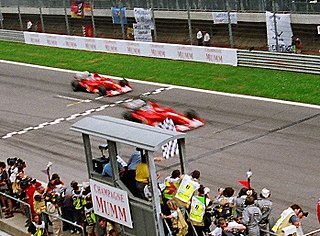 W
WIn motor racing, team orders is the practice of teams issuing instructions to drivers to deviate from the normal practice of racing against each other as they would against other teams' drivers. This can be accomplished either in advance, simply by establishing a pecking order between the drivers within the team, or instructing a driver to let their teammate overtake or to hold position without the risk of collision.
 W
WA Burt strut, also known as a timing strut or beam splitter, is a black, rectangular plate attached to the front of a competition vehicle, usually a racing car, to provide a standardised, repeatable method by which to break a timing light beam at the start and finish of events timed to high-degrees of accuracy. These events are commonly those in which competitors race against the clock, rather than physically against another vehicle, such as sprint or hillclimb races. The strut was invented in 1967 by Ron Smith; manager, chief mechanic and future husband to 1970 British sprint champion Patsy Burt. As the strut made its first appearance on the front of Burt's McLaren-Oldsmobile her name was used as its official title. In recent years the generic term timing strut has also become common.
 W
WIn telecommunication, a transponder is a device that, upon receiving a signal, emits a different signal in response. The term is a portmanteau of transmitter and responder. It is variously abbreviated as XPDR, XPNDR, TPDR or TP.
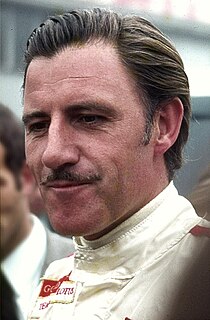 W
WThe Triple Crown of Motorsport is an unofficial motorsport achievement, often regarded as winning three of the most prestigious motor races in the world in one's career:the Indianapolis 500 the 24 Hours of Le Mans the Monaco Grand Prix
 W
WA victory lap is a term used in motorsports to describe an extra lap of the race track after the conclusion of a race. This lap, driven at reduced speed, allows the winning driver to celebrate their victory and gives the spectators an opportunity to congratulate and honor the competitors. Commonly, trackside flag marshals will wave their flags in a gesture known as the FIA salute or the Monkey Dance in the US. It is not uncommon for marshals to clap or wave their hands at drivers as a gesture and sometimes the drivers wave back in response.
 W
WA suspension keel is an extension pylon to the bodywork of single-seat, open wheel racing cars designed with a raised nose cone, to allow the lower suspension arms to be attached to the car approximately parallel to the road surface. In recent years the placing and design of a suspension keel, or the lack of such, has been one of the few distinct variables in Formula One chassis design.